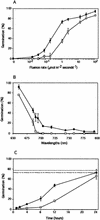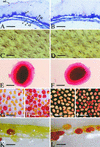Inactivation of the phloem-specific Dof zinc finger gene DAG1 affects response to light and integrity of the testa of Arabidopsis seeds
- PMID: 11842145
- PMCID: PMC148904
- DOI: 10.1104/pp.010488
Inactivation of the phloem-specific Dof zinc finger gene DAG1 affects response to light and integrity of the testa of Arabidopsis seeds
Abstract
We show here that seeds from the knockout mutant of the Arabidopsis DAG1 gene encoding a Dof zinc finger transcription factor have an altered response to red and far-red light. Mutant dag1 seeds are induced to germinate by much lower red light fluence rates, and germination reaches more quickly a point where it is independent of phytochrome signaling. Moreover, although microscopic analysis reveals no obvious structural alterations in the seed coat (testa) of dag1 seeds, staining assays with different dyes point to an abnormal fragility of the testa. By extensive in situ mRNA hybridization analysis we show here that the gene, which is not expressed in the embryo, is specifically expressed in the phloem of all organs of the mother plant.
Figures



Similar articles
-
DOF AFFECTING GERMINATION 2 is a positive regulator of light-mediated seed germination and is repressed by DOF AFFECTING GERMINATION 1.BMC Plant Biol. 2015 Mar 4;15:72. doi: 10.1186/s12870-015-0453-1. BMC Plant Biol. 2015. PMID: 25850831 Free PMC article.
-
Identification and disruption of an Arabidopsis zinc finger gene controlling seed germination.Genes Dev. 2000 Jan 1;14(1):28-33. Genes Dev. 2000. PMID: 10640273 Free PMC article.
-
Mutations in the Dof zinc finger genes DAG2 and DAG1 influence with opposite effects the germination of Arabidopsis seeds.Plant Cell. 2002 Jun;14(6):1253-63. doi: 10.1105/tpc.010491. Plant Cell. 2002. PMID: 12084825 Free PMC article.
-
Insights into structural and functional diversity of Dof (DNA binding with one finger) transcription factor.Planta. 2015 Mar;241(3):549-62. doi: 10.1007/s00425-014-2239-3. Epub 2015 Jan 7. Planta. 2015. PMID: 25564353 Review.
-
The emerging functions of mini zinc finger (MIF) microproteins in seed plants: A minireview.Biochimie. 2024 Mar;218:69-75. doi: 10.1016/j.biochi.2023.09.016. Epub 2023 Sep 16. Biochimie. 2024. PMID: 37722501 Review.
Cited by
-
DOF AFFECTING GERMINATION 2 is a positive regulator of light-mediated seed germination and is repressed by DOF AFFECTING GERMINATION 1.BMC Plant Biol. 2015 Mar 4;15:72. doi: 10.1186/s12870-015-0453-1. BMC Plant Biol. 2015. PMID: 25850831 Free PMC article.
-
One hundred and one new microsatellite loci derived from ESTs (EST-SSRs) in bread wheat.Theor Appl Genet. 2004 May;108(7):1392-400. doi: 10.1007/s00122-003-1554-z. Epub 2004 Feb 14. Theor Appl Genet. 2004. PMID: 14968301
-
Communication between the maternal testa and the embryo and/or endosperm affect testa attributes in tomato.Plant Physiol. 2003 Sep;133(1):145-60. doi: 10.1104/pp.103.022632. Plant Physiol. 2003. PMID: 12970482 Free PMC article.
-
Transcription factor CDF4 promotes leaf senescence and floral organ abscission by regulating abscisic acid and reactive oxygen species pathways in Arabidopsis.EMBO Rep. 2020 Jul 3;21(7):e48967. doi: 10.15252/embr.201948967. Epub 2020 Jun 2. EMBO Rep. 2020. PMID: 32484317 Free PMC article.
-
Genome-wide comparative phylogenetic analysis of the rice and Arabidopsis Dof gene families.BMC Evol Biol. 2003 Jul 23;3:17. doi: 10.1186/1471-2148-3-17. Epub 2003 Jul 23. BMC Evol Biol. 2003. PMID: 12877745 Free PMC article.
References
-
- Aastrup S, Outtrup H, Erdal K. Location of the proanthocyanidins in the barley grain. Carlsberg Res Commun. 1984;49:105–109.
-
- Chen W, Chao G, Singh K. The promoter of a H2O2-inducible, Arabidopsis glutathione S-transferase gene contains closely linked OBF- and OBP-binding sites. Plant J. 1996;10:955–966. - PubMed
Publication types
MeSH terms
Substances
LinkOut - more resources
Full Text Sources
Other Literature Sources
Molecular Biology Databases
Miscellaneous

